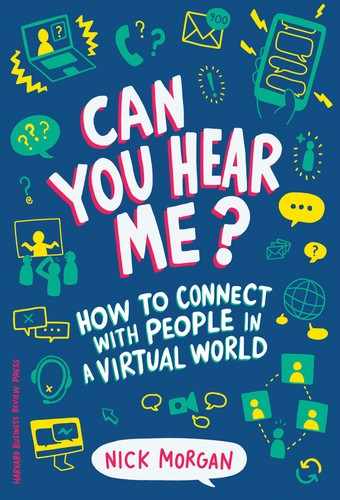PROLOGUE
IS THIS THING ON?
We are all unwitting participants in a massive social experiment that began slowly after World War II and gathered speed in the last decade with the introduction of the smartphone. We have created virtual personas, online worlds, digital connections, social media lives, email relationships, audioconference teams—the whole panoply of ways that we now communicate with one another virtually.
That ability to communicate virtually seemed at first to be an unmitigated advance. We could communicate faster, more easily, with less friction, at our own convenience, to multiples of our previous audiences, with the click of a mouse or a “send” button.
Only recently have we started to realize that this huge social experiment has a downside, too. We’ve started to worry about shorter attention spans, and we wonder if the internet makes us stupid. But the real downside has remained largely invisible to us because it touches on the workings of our unconscious minds.
As we’ve made room for virtual communication in our lives, our workplaces, and in all the ways we connect with one another, we haven’t fully realized how emotionally empty virtual communications are. Every form of virtual communication strips out the emotional subtext of our communications to a greater or lesser extent. Every one.
Take email, for example. We’ve all experienced the frustration of sending an email that was (to us) obviously meant to be a joke. But the recipient, instead of being amused, was offended, and we had to spend huge amounts of time repairing the relationship. That’s the simplest, most obvious form of emotional undercutting that virtual communications foist on us.
Most of us have also spent hours on audioconferences at work, with the mute button in force, taking care of other business while people on the other end of the box drone on endlessly. We’ve had to lunge for that mute button when the boss suddenly says, “Nick, are you still on? What do you think of the new cross-eyed widget?”
And then there’s social media, which would seem to be all about emotional connection but in fact is like Pringles potato chips; you need to keep eating them because one chip doesn’t satisfy. The bland taste creates a need for more but doesn’t allow you to stop. We get one like on Facebook, enjoy a brief hit of pleasure, and crave more. We get social love on Twitter and Instagram, and it’s just enough to keep us checking our mobile phones hundreds of times per day. In short, we’ve transferred a surprisingly large amount of our human interactions to the virtual world, and as a result, we no longer get the emotional information, support, and reinforcement we used to get without thinking about it while communicating face-to-face.
Virtual relationships are more fragile and easily disrupted because they lack the unconscious connections our face-to-face interactions automatically convey. The lift of an eyebrow, the tone of a voice, a quick smile, a shake of the head—these are the ways we decode other people’s intents. These signals are largely absent from all forms of digital communication.
In business, this absence leads to miscommunication, misunderstandings, and a huge amount of do-overs, workarounds, and relationship repair. It’s expensive. It’s inefficient. And the cost in fractured relationships, missed opportunities, and lost connections is incalculable. Because we make decisions with our emotions, moreover, when we take them out of the communication, the audioconference, or the webinar, it becomes almost impossible to make good decisions when we’re immersed in the virtual stream.
In our personal lives, the same problems occur, especially when we’re trying to connect with someone at a distance, virtually. It’s expensive in many less quantifiable ways.
The result of this massive social experiment is a huge increase in loneliness, social isolation, fear of missing out (FOMO), and Instagram/Facebook envy, and, tragically, teenage depression and even suicide. We may be raising a generation of people who are unhappy communicating virtually and incompetent communicating face-to-face. Those of us with one foot in the face-to-face world and one foot in the virtual world are torn. We are invested in both, but we lack the time to master either world or feel completely at home in both.
What’s to be done? The experiment will continue. We can’t live without our gadgets. Too much of our personal and work lives today relies on the virtual. Indeed, most organizations with an international reach couldn’t function without the digital means of communication they use every day.
But we need to learn to live smarter and communicate differently to survive in this brave new digital world. We need to begin to consciously add the emotional subtext back into our virtual communications to avoid the costs—personal and financial—associated with miscommunication.
That’s the subject of this book.
